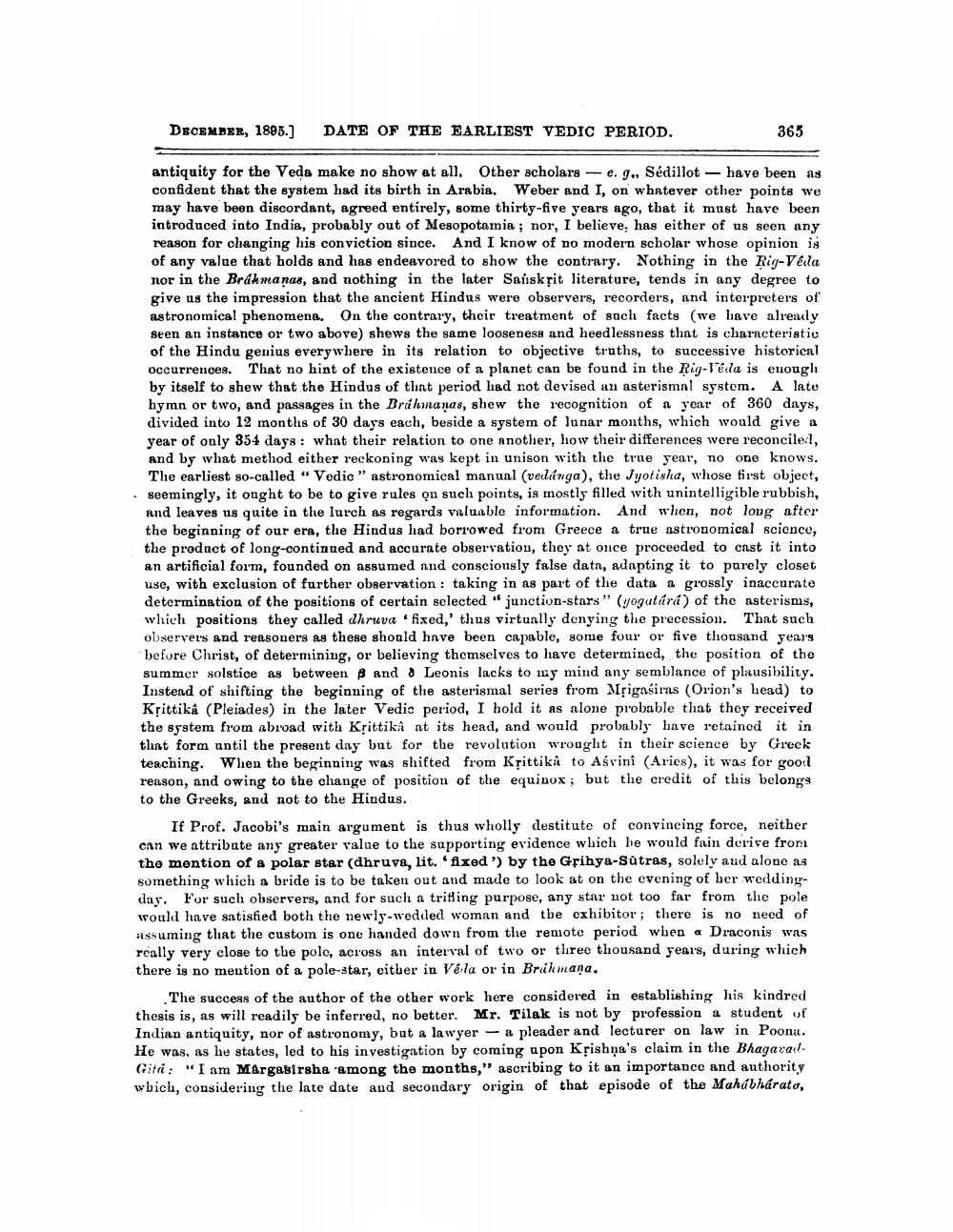________________
DECEMBER, 1895.)
DATE OF THE EARLIEST VEDIC PERIOD.
365
antiquity for the Veda make no show at all. Other scholars - e. 9., Sédillot - have been as confident that the system had its birth in Arabia. Weber and I, on whatever other points we may have been discordant, agreed entirely, some thirty-five years ago, that it must have been introduced into India, probably out of Mesopotamia ; nor, I believe, has either of us seen any reason for changing his conviction since. And I know of no modern scholar whose opinion is of any value that holds and has endeavored to show the contrary. Nothing in the Rig Véla nor in the Brakmanas, and nothing in the later Saiskřit literature, tends in any degree to give us the impression that the ancient Hindus were observers, recorders, and interpreters of astronomical phenomena. On the contrary, their treatment of such facts (we have already seen an instance or two above) shews the same looseness and heedlessness that is characteristic of the Hindu genius everywhere in its relation to objective truths, to successive historical occurrences. That no hint of the existence of a planet can be found in the Rig-Tecla is enough by itself to shew that the Hindus of thint period had not devised an asterismal system. A late hymn or two, and passages in the Brahmanas, shew the recognition of a year of 360 days, divided into 12 months of 30 days each, beside a system of lunar months, which would give a year of only 354 days : what their relation to one another, how their differences were reconciled, and by what method either reckoning was kept in unison with the true year, no one knows. The earliest so-called " Vedic" astronomical manual (vedlinga), the Jyotisha, whose first object, seemingly, it ought to be to give rules on such points, is mostly filled with unintelligible rubbish, and leaves us quite in the lurch as regards valuable information. And when, not long after the beginning of our era, the Hindus had borrowed from Greece a true astronomical science, the product of long-continued and accurate observation, they at once proceeded to cast it into an artificial form, founded on assumed and consciously false data, adapting it to parely closet use, with exclusion of further observation : taking in as part of the data a grossly inaccurate determination of the positions of certain selected "junction-stars" (yogutári) of the asterisms, which positions they called Thruva fixed,' thus virtually denying the precession. That such observers and reasoners as these shonld have been capable, some four or five thousand years before Christ, of determining, or believing themselves to have determined, the position of the summer solstice as between B and 8 Leonis lacks to my mind any semblance of plausibility. Instead of shifting the beginning of the asterismal series from Mrigasiras (Orion's head) to Ksittika (Pleiades) in the later Vedic period, I hold it as alone probable that they received the system from abroad with Krittika at its head, and would probably have retained it in that form until the present day but for the revolution wrought in their science by Greck teaching. When the beginning was shifted from Kșittika to Asvini (Aries), it was for good reason, and owing to the change of position of the equinox; but the credit of this belongs to the Greeks, and not to the Hindus.
If Prof. Jacobi's main argument is thus wholly destitute of convincing force, neither can we attribute any greater value to the supporting evidence which he would fain derive from the mention of a polar star (dhruva, lit. 'fixed ') by the Gfihya-Sutras, solely and alone as something which a bride is to be taken out and made to look at on the evening of her weddingday. For such observers, and for such a trifling purpose, any star not too far from the pole would have satisfied both the newly-wedded woman and the exhibitor; there is no need of assuming that the custom is one handed down from the remote period when a Draconis was really very close to the pole, across an interval of two or three thousand years, during which there is no mention of a pole-star, either in Véla or in Brih mana.
The success of the author of the other work here considered in establishing his kindred thesis is, as will readily be inferred, no better. Mr. Tilak is not by profession a student of Indian antiquity, nor of astronomy, but a lawyer - a pleader and lecturer on law in Poona. He was, as he states, led to his investigation by coming upon Krishna's claim in the Bhagavail. Gita: "I am Margasirsha among the months," ascribing to it an importance and authority wbich, considering the late date and secondary origin of that episode of the Mahabharata,




